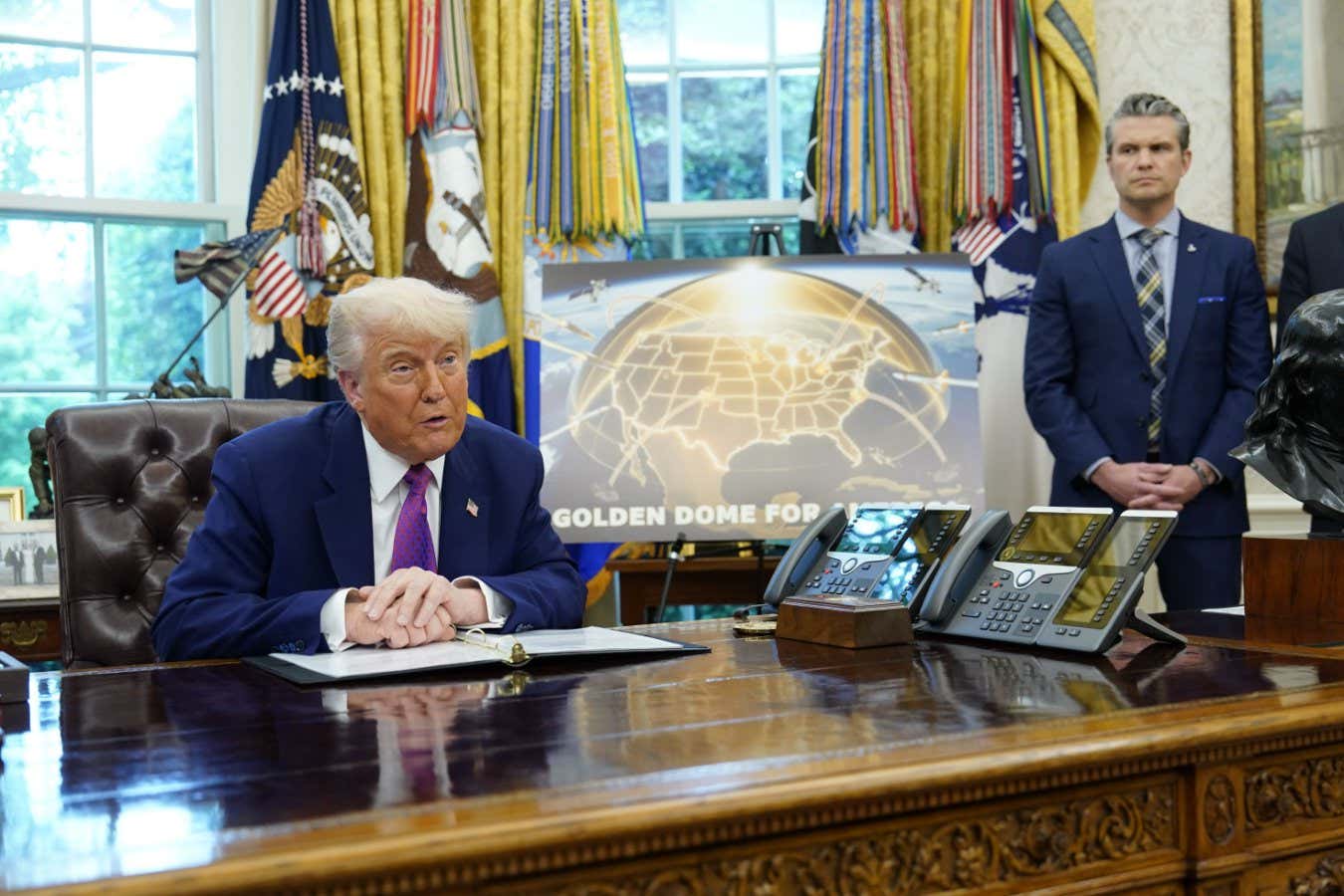Now Reading: Trump’s Golden Dome defence project could spur a space arms race
-
01
Trump’s Golden Dome defence project could spur a space arms race
Trump’s Golden Dome defence project could spur a space arms race


US President Donald Trump (left), accompanied by US Secretary of Defense Pete Hegseth (right), announces the Golden Dome missile defense shield
CHRIS KLEPONIS/POOL/EPA-EFE/Shutterstock
US President Donald Trump has proposed a defence project, called the Golden Dome, to intercept any incoming hypersonic, ballistic and advanced cruise missiles that threaten the country.
“Once fully constructed, the Golden Dome will be capable of intercepting missiles even if they are launched from other sides of the world and even if they are launched from space,” said Trump during the White House announcement on 20 May.
But such a thorough interception system may not be possible. Some experts also warn that, even if it works, the Golden Dome would take at least a decade to build, cost more than half a trillion dollars – and accelerate the global nuclear arms race and the weaponisation of space.
What is the Golden Dome?
The project’s name is inspired by Israel’s Iron Dome system, which uses ground-based missiles to intercept incoming rockets and artillery fired from relatively short distances. But the Golden Dome would need to defend a far larger area – the land mass of the contiguous US alone is more than 350 times the size of Israel – from a wider variety of sophisticated missiles.
According to Trump and his officials, the system should be able to counter ballistic missiles that could be launched from the other side of the world, advanced cruise missiles that fly on flatter trajectories at lower altitudes and hypersonic missiles that can fly and manoeuvre at speeds exceeding Mach 5, five times the speed of sound. These missiles can carry either nuclear warheads or conventional explosive warheads.
To detect and intercept the threats, the Golden Dome will use both “space-based sensors and air and missile defense”, US Secretary of Defense Pete Hegseth said in a statement. That implies an umbrella system of “Golden Domes” with different technologies countering different threats, says David Burbach at the Naval War College in Rhode Island, who shared some comments with New Scientist in a personal capacity.
However, not all of these defences exist. For instance, the Golden Dome would supposedly use space-based interceptor missiles in low Earth orbit, an unprecedented technological feat that has never been demonstrated before, says Thomas González Roberts at the Georgia Institute of Technology in Atlanta.
A similar idea, nicknamed Star Wars, was originally proposed by US President Ronald Reagan in his Strategic Defense Initiative during the cold war. In fact, Trump has described the Golden Dome as an effort to complete “the job that President Reagan started 40 years ago”.
How will the Golden Dome work?
Missile defence experts describe the challenge of intercepting long-range nuclear missiles as being like “hitting a bullet with a bullet, in the dark” because “the targets are small, not emitting any radio or infrared signals, and fast moving”, says Burbach. “One thing to keep in mind is that even optimistic technical experts admit 100 per cent interception is unlikely.”
The US already has a system of ground-based interceptor missiles, primarily based in Alaska. They can shoot down “a couple dozen incoming warheads at best”, says Burbach. He also pointed out that Russia and China are developing countermeasures to make it harder to detect and intercept their missiles.
“Stopping subsonic cruise missiles or short-range ballistic missiles launched from just outside US borders would use established technology, but it could be expensive to deploy enough of those defensive systems to cover the whole country,” says Burbach. “The real challenge will be Golden Dome’s aim to stop large numbers of intercontinental missiles – President Trump said ‘100 per cent’ of them – such as an attack from China or Russia.”
Trump’s claim that the Golden Dome would defend against missile strikes from the other side of the world or even from space implies it would require a “dense constellation of likely low-Earth orbiting, space-based missile interceptors that could deorbit and strike a missile within minutes of it launching” from anywhere, says Roberts.
“The number of satellites you would need is bigger than any constellation that’s ever been launched,” he says. Currently, the largest constellation consists of around 7000 Starlink satellites operated by SpaceX.
How much will the Golden Dome cost?
Trump proposed a budget of $175 billion for the Golden Dome, although that funding has not yet been approved by the US Congress. And the Congressional Budget Office, a nonpartisan federal agency, estimated that a space-based interceptor system like Golden Dome could cost as much as $542 billion.
“It’s unclear what expenditures are included in the $175 billion figure,” says Patrycja Bazylczyk at the Center for Strategic & International Studies, a think tank in Washington DC.
Trump also claimed the Golden Dome would be “fully operational” by the end of his second term in office in early 2029, although experts doubt that is possible. “The three-year timeline is aggressive – this initiative is likely to span at least a decade, if not more,” says Bazylczyk.
Much of the timeline may depend upon how many existing military systems it uses. “Significant progress is feasible in the near term, including fielding new interceptors, over-the-horizon radars, space-based sensors and technology demonstrations,” says Bazylczyk.
But there are major limitations to how quickly the US could launch the potentially thousands of satellites required for Golden Dome – to say nothing of developing the space-based interceptor technologies.
“I think you’d be very hard-pressed to find a launch cadence that could support a large constellation going up in just three years,” says Roberts. “SpaceX launches more things more often than anyone in the history of space operations, and the ask here is to crack open that ceiling even further.”
“I think it is almost impossible a system could be ‘fully operational’ in the sense of ‘stop 100 per cent of a missile attack’ that quickly,” says Burbach. “Reaching even a small-scale operational capability that soon would be very difficult.”
Will Golden Dome make the US safer?
There is already an ongoing arms race between the US, China and Russia, with all three countries modernising and expanding their nuclear arsenals, as well as developing space-based systems to support their militaries.
If the Golden Dome system can improve US air and missile defences, it could “change the strategic calculus” by reducing the confidence of any missile-armed adversary, deterring them from launching attacks in the first place, says Bazylczyk.
On the other hand, the Golden Dome has the “potential to contribute to instability” by “signalling to your nuclear adversaries that you simply don’t trust them”, says Roberts. China’s foreign ministry responded to Trump’s announcement by saying the Golden Dome carries “strong offensive implications” and raises the risks of an arms race in space. A Kremlin spokesperson suggested the Golden Dome plans could lead to resumption of nuclear arms control discussions between Russia and the US.
To counter this system, China and Russia might try to “destroy or disable US satellites”, says Burbach. Both countries already have missiles capable of shooting down satellites, and they could also try to electronically jam or hack US satellite systems, he says. In February 2024, the US government warned that Russia had plans to launch a space weapon capable of disabling or destroying satellites, possibly using a nuclear explosion.
These countries could also bulk up their missile arsenals and possibly develop more manoeuvrable weapons that also use decoys, says Burbach. He pointed out that Russia has already started developing weapons less vulnerable to space-based interception, such as intercontinental nuclear torpedoes that travel underwater.
Topics:




















